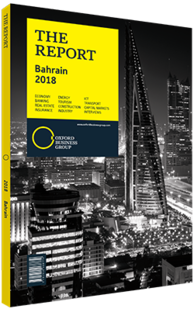Bahrain increases electricity production to meet demand
With Bahrain’s population and industrial footprint growing at pace, the kingdom has had to expand its electricity infrastructure. According to the Ministry of Electricity and Water Affairs, Bahrain has an available electricity capacity of nearly 3921 MW, with peak demand hitting 3418 MW in summer 2016. At the same time, top estimates have peak demand reaching around 4500 MW in 2020, with a low forecast of approximately 4100 MW. This will require significant new power supplies coming on-line in the near future, as well as upgrades to the distribution network.
INFRASTRUCTURE INVESTMENT: Infrastructure developments are ongoing. Bahrain’s electricity and water master plan sets out the roadmap for the development of electricity and water infrastructure until 2030. In June 2017 the Electricity and Water Authority (EWA) closed its prequalification process for developers interested in the tender round for the Al Dur 2 Independent Water and Power Project, a $1.5bn gas-fired plant set to be constructed on a build-own-operate basis. The facility is expected to have a generation capacity of 1200-1500 MW when complete, with construction set to begin in the first quarter of 2019 and a second phase to be commissioned in 2020. The initial Al Dur Independent Water and Power Project was completed in 2012 at a cost of $2.1bn, and involved the installation of four gas turbines and two steam turbine units, with a total capacity of 1.2 GW.
The new plant is expected to help the kingdom meet its growing energy demand, which is increasing by 7-10% per year and is expected to reach approximately 20,000 GWh by 2020, according to data from the World Bank. Between 2017 and 2020 peak demand is estimated to average 4312 MW per month.
POWERING INDUSTRY: In August 2017 General Electric (GE) Energy Financial Services announced that it had successfully secured funding for the 1.79-GW combined-cycle facility being built to power the Line 6 expansion project at state-owned Aluminium Bahrain (Alba), which is set to come on-line in the first quarter of 2019. The plant will have three 9HA gas turbines, three steam turbines and three heat recovery steam generators, with Swiss export credit agency SERV providing the loans for goods and services and additional financing coming from Standard Chartered, Commerzbank from Germany, France’s Crédit Agricole and US-based Citibank and JP Morgan. Reinsurance for the facility is being provided by French ECA Bpifrance and Italian ECA SACE, while a consortium consisting of GE Power and GAMA Power Systems was awarded the engineering, procurement and construction contract in 2016.
SUBSTATIONS: In 2017 the kingdom completed a number of new electricity substations. In June 2017 a 66-KV station was opened in Hajjiyat, along with a 220-KV substation that forms part of Bahrain International Airport station and a 66-KV substation which is part of the airport’s western plant. The 220-KV station will feed the new airport terminal building, and cost BD17.2m ($45.6m). According to local media, it is one of 15, 220-KV facilities that will be installed in Muharraq, along with 48, 66-KV substations. Two other substations are scheduled for completion in Al Hamal and Ras Zuwaid, with the Al Hamal station having a 220-KV capacity and the Ras Zuwaid station having a capacity of 66 KV.
In addition, a new, 400-KV transmission network, costing BD180m ($477.2m), was announced in May 2016. It is set to overlay the existing 220-KV network and enable expansion as well as the cost-efficient transfer of bulk power. Completion of the network is expected in the second quarter of 2018, with Italian manufacturer Prysmian Group providing the transmission lines and South Korea’s Hyundai supplying the transformers. The overall project is being implemented by German company Siemens.
EFFICIENCY: Efforts are also under way to improve the efficiency of electricity usage, and a tender was opened by EWA in the third quarter of 2016 for the supply and installation of a smart-meter data management system.
You have reached the limit of premium articles you can view for free.
Choose from the options below to purchase print or digital editions of our Reports. You can also purchase a website subscription giving you unlimited access to all of our Reports online for 12 months.
If you have already purchased this Report or have a website subscription, please login to continue.

